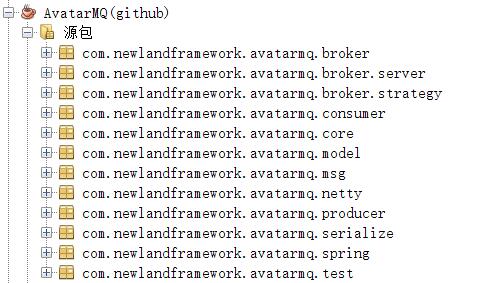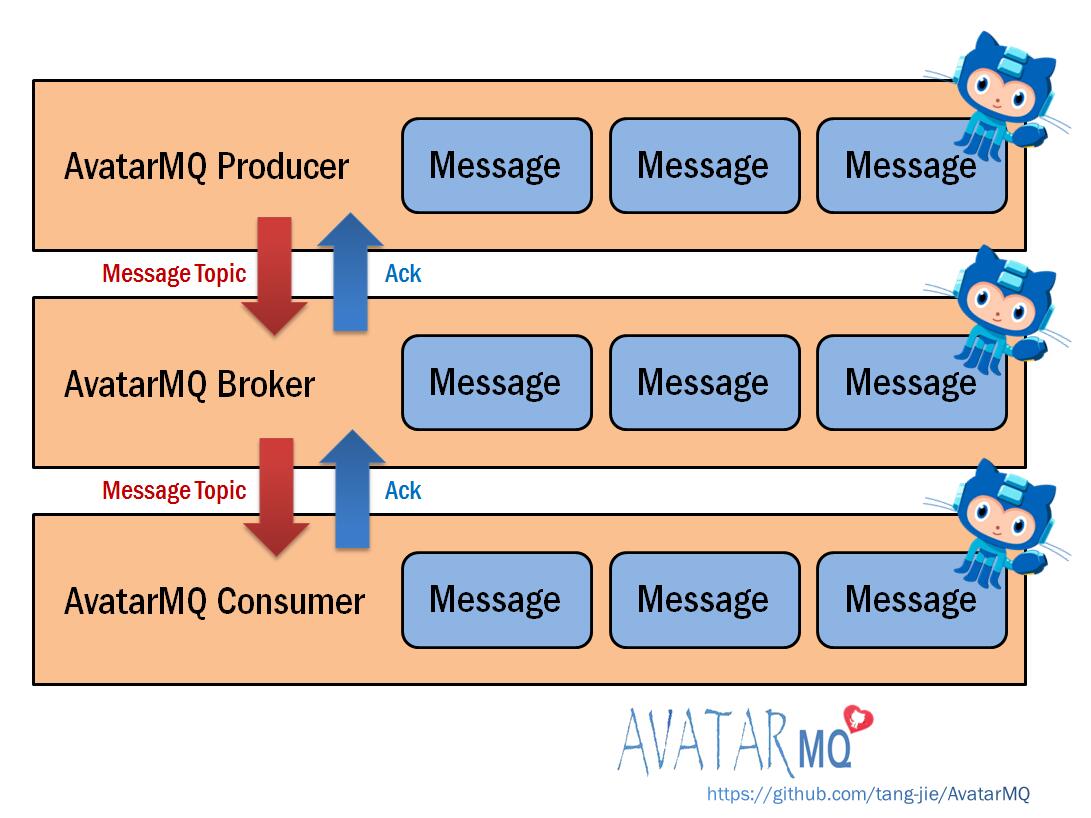在本人的上一篇博客文章:Netty構建分散式消息隊列(AvatarMQ)設計指南之架構篇 中,重點向大家介紹了AvatarMQ主要構成模塊以及目前存在的優缺點。最後以一個生產者、消費者傳遞消息的例子,具體演示了AvatarMQ所具備的基本消息路由功能。而本文的寫作目的,是想從開發、設計的角度,簡單的 ...
在本人的上一篇博客文章:Netty構建分散式消息隊列(AvatarMQ)設計指南之架構篇 中,重點向大家介紹了AvatarMQ主要構成模塊以及目前存在的優缺點。最後以一個生產者、消費者傳遞消息的例子,具體演示了AvatarMQ所具備的基本消息路由功能。而本文的寫作目的,是想從開發、設計的角度,簡單的對如何使用Netty,構建分散式消息隊列背後的技術細節、原理,進行一下簡單的分析和說明。
首先,在一個企業級的架構應用中,究竟何時需引入消息隊列呢?本人認為,最經常的情況,無非這幾種:做業務解耦、事件消息廣播、消息流控處理。其中,對於業務解耦是作為消息隊列,要解決的一個首要問題。所謂業務解耦,就是說在一個業務流程處理上,只關註具體的流程,盡到通知的責任即可,不必等待消息處理的結果。
總得來看,企業級系統模塊通信的方式通常情況下,無非兩種。
同步方式:REST、RPC方式實現;非同步方式:消息中間件(消息隊列)方式實現。
同步方式的優點:可以基於http協議之上,無需中間件代理,系統架構相對而言比較簡單。缺點是:客戶端和服務端緊密耦合,並且要實時線上通信,否則會導致消息發送失敗。
非同步方式的優點:客戶端和服務端互相解耦,雙方可以不產生依賴。缺點是:由於引入了消息中間件,在編程的時候會增加難度繫數。此外,消息中間件的可靠性、容錯性、健壯性往往成為這類架構的決定性因素。
舉一個本人工作中的例子向大家說明一下:移動業務中的產品訂購中心,每當一個用戶通過某些渠道(營業廳、自助終端等等)開通、訂購了某個套餐之後,如果這些套餐涉及第三方平臺派單的話,產品訂購中心會向第三方平臺發起訂購請求操作。試想一下,如果遇到高峰受理時間段,由於業務受理量的激增,導致一些外圍系統的響應速度降低(比如業務網關響應速度不及時、網路延時等等原因),最終用戶開通一個套餐花在主流程的時間會延長很多,這個會造成極不好的用戶體驗,最終可能導致受理失敗。在上述的場景裡面,我們就可以很好的引入一個消息隊列進行業務的解耦,具體來說,產品訂購中心只要“通知”第三方平臺,我們的套餐開通成功了,並不一定非要同步阻塞地等待其真正的開通處理完成。正因為如此,消息隊列逐漸成為當下系統模塊通信的主要方式手段。
當今在Java的消息隊列通信領域,有很多主流的消息中間件,比如RabbitMQ、ActiveMQ、以及炙手可熱Kafka。其中ActiveMQ是基於JMS的標準之上開發定製的一套消息隊列系統,性能穩定,訪問介面也非常友好,但是這類的消息隊列在訪問吞吐量上有所折扣;另外一個方面,比如Kafka這樣,以高效吞吐量著稱的消息隊列系統,但是在穩定性和可靠性上,能力似乎還不夠,因此更多的是用在服務日誌傳輸、短消息推送等等對於可靠性不高的業務場景之中。總結起來,不管是ActiveMQ還是Kafka,其框架的背後涉及到很多非同步網路通信、多線程、高併發處理方面的專業技術知識。但本文的重點,也不在於介紹這些消息中間件背後的技術細節,而是想重點闡述一下,如何透過上述消息隊列的基本原理,在必要的時候,開發定製一套符合自身業務要求的消息隊列系統時,能夠獲得更加全面的視角去設計、考量這些問題。
因此本人用心開發實現了一個,基於Netty的消息隊列系統:AvatarMQ。當然,在設計、實現AvatarMQ的時候,我會適當參考這些成熟消息中間件中用到的很多重要的思想理念。
當各位從github上面下載到AvatarMQ的源代碼的時候,可以發現,其中的包結構如下所示:

現在對每個包的主要功能進行一下簡要說明(下麵省略首碼com.newlandframework.avatarmq)。
broker:消息中間件的伺服器模塊,主要負責消息的路由、負載均衡,對於生產者、消費者進行消息的應答回覆處理(ACK),AvatarMQ中的中心節點,是連接生產者、消費者的橋梁紐帶。
consumer:消息中間件中的消費者模塊,負責接收生產者過來的消息,在設計的時候,會對消費者進行一個集群化管理,同一個集群標識的消費者,會構成一個大的消費者集群,作為一個整體,接收生產者投遞過來的消息。此外,還提供消費者接收消息相關的API給客戶端進行調用。
producer:消息中間件中的生產者模塊,負責生產特定主題(Topic)的消息,傳遞給對此主題感興趣的消費者,同時提供生產者生產消息的API介面,給客戶端使用。
core:AvatarMQ中消息處理的核心模塊,負責消息的記憶體存儲、應答控制、對消息進行多線程任務分派處理。
model:主要定義了AvatarMQ中的數據模型對象,比如MessageType消息類型、MessageSource消息源頭等等模型對象的定義。
msg:主要定義了具體的消息類型對應的結構模型,比如消費者訂閱消息SubscribeMessage、消費者取消訂閱消息UnSubscribeMessage,消息伺服器應答給生產者的應答消息ProducerAckMessage、消息伺服器應答給消費者的應答消息ConsumerAckMessage。
netty:主要封裝了Netty網路通信相關的核心模塊代碼,比如訂閱消息事件的路由分派策略、消息的編碼、解碼器等等。
serialize:利用Kryo這個優秀高效的對象序列化、反序列框架對消息對象進行序列化網路傳輸。
spring:Spring的容器管理類,負責把AvatarMQ中的消息伺服器模塊:Broker,進行容器化管理。這個包裡面的AvatarMQServerStartup是整個AvatarMQ消息伺服器的啟動入口。
test:這個就不用多說了,就是針對AvatarMQ進行消息路由傳遞的測試demo。
AvatarMQ運行原理示意圖:

首先是消息生產者客戶端(AvatarMQ Producer)發送帶有主題的消息給消息轉發伺服器(AvatarMQ Broker),消息轉發伺服器確認收到生產者的消息,發送ACK應答給生產者,然後把消息繼續投遞給消費者(AvatarMQ Consumer)。同時broker伺服器接收來自消費者的訂閱、取消訂閱消息,併發送ACK應該給對應的消費者,整個消息系統就是這樣周而複始的工作。
現在再來看一下,AvatarMQ中的核心模塊的組成,如下圖所示:

Producer Manage:消息的生產者,其主要代碼在(com.newlandframework.avatarmq.producer)包之下,其主要代碼模塊關鍵部分簡要說明如下:
package com.newlandframework.avatarmq.producer; import com.newlandframework.avatarmq.core.AvatarMQAction; import com.newlandframework.avatarmq.model.MessageSource; import com.newlandframework.avatarmq.model.MessageType; import com.newlandframework.avatarmq.model.RequestMessage; import com.newlandframework.avatarmq.model.ResponseMessage; import com.newlandframework.avatarmq.msg.Message; import com.newlandframework.avatarmq.msg.ProducerAckMessage; import com.newlandframework.avatarmq.netty.MessageProcessor; import java.util.concurrent.atomic.AtomicLong; /** * @filename:AvatarMQProducer.java * @description:AvatarMQProducer功能模塊 * @author tangjie<https://github.com/tang-jie> * @blog http://www.cnblogs.com/jietang/ * @since 2016-8-11 */ public class AvatarMQProducer extends MessageProcessor implements AvatarMQAction { private boolean brokerConnect = false; private boolean running = false; private String brokerServerAddress; private String topic; private String defaultClusterId = "AvatarMQProducerClusters"; private String clusterId = ""; private AtomicLong msgId = new AtomicLong(0L); //連接消息轉發伺服器broker的ip地址,以及生產出來消息附帶的主題信息 public AvatarMQProducer(String brokerServerAddress, String topic) { super(brokerServerAddress); this.brokerServerAddress = brokerServerAddress; this.topic = topic; } //沒有連接上消息轉發伺服器broker就發送的話,直接應答失敗 private ProducerAckMessage checkMode() { if (!brokerConnect) { ProducerAckMessage ack = new ProducerAckMessage(); ack.setStatus(ProducerAckMessage.FAIL); return ack; } return null; } //啟動消息生產者 public void start() { super.getMessageConnectFactory().connect(); brokerConnect = true; running = true; } //連接消息轉發伺服器broker,設定生產者消息處理鉤子,用於處理broker過來的消息應答 public void init() { ProducerHookMessageEvent hook = new ProducerHookMessageEvent(); hook.setBrokerConnect(brokerConnect); hook.setRunning(running); super.getMessageConnectFactory().setMessageHandle(new MessageProducerHandler(this, hook)); } //投遞消息API public ProducerAckMessage delivery(Message message) { if (!running || !brokerConnect) { return checkMode(); } message.setTopic(topic); message.setTimeStamp(System.currentTimeMillis()); RequestMessage request = new RequestMessage(); request.setMsgId(String.valueOf(msgId.incrementAndGet())); request.setMsgParams(message); request.setMsgType(MessageType.AvatarMQMessage); request.setMsgSource(MessageSource.AvatarMQProducer); message.setMsgId(request.getMsgId()); ResponseMessage response = (ResponseMessage) sendAsynMessage(request); if (response == null) { ProducerAckMessage ack = new ProducerAckMessage(); ack.setStatus(ProducerAckMessage.FAIL); return ack; } ProducerAckMessage result = (ProducerAckMessage) response.getMsgParams(); return result; } //關閉消息生產者 public void shutdown() { if (running) { running = false; super.getMessageConnectFactory().close(); super.closeMessageConnectFactory(); } } public String getTopic() { return topic; } public void setTopic(String topic) { this.topic = topic; } public String getClusterId() { return clusterId; } public void setClusterId(String clusterId) { this.clusterId = clusterId; } }
Consumer Clusters Manage / Message Routing:消息的消費者集群管理以及消息路由模塊,其主要模塊在包(com.newlandframework.avatarmq.consumer)之中。其中消息消費者對象,對應的核心代碼主要功能描述如下:
package com.newlandframework.avatarmq.consumer; import com.google.common.base.Joiner; import com.newlandframework.avatarmq.core.AvatarMQAction; import com.newlandframework.avatarmq.core.MessageIdGenerator; import com.newlandframework.avatarmq.core.MessageSystemConfig; import com.newlandframework.avatarmq.model.MessageType; import com.newlandframework.avatarmq.model.RequestMessage; import com.newlandframework.avatarmq.msg.SubscribeMessage; import com.newlandframework.avatarmq.msg.UnSubscribeMessage; import com.newlandframework.avatarmq.netty.MessageProcessor; /** * @filename:AvatarMQConsumer.java * @description:AvatarMQConsumer功能模塊 * @author tangjie<https://github.com/tang-jie> * @blog http://www.cnblogs.com/jietang/ * @since 2016-8-11 */ public class AvatarMQConsumer extends MessageProcessor implements AvatarMQAction { private ProducerMessageHook hook; private String brokerServerAddress; private String topic; private boolean subscribeMessage = false; private boolean running = false; private String defaultClusterId = "AvatarMQConsumerClusters"; private String clusterId = ""; private String consumerId = ""; //連接的消息伺服器broker的ip地址以及關註的生產過來的消息鉤子 public AvatarMQConsumer(String brokerServerAddress, String topic, ProducerMessageHook hook) { super(brokerServerAddress); this.hook = hook; this.brokerServerAddress = brokerServerAddress; this.topic = topic; } //向消息伺服器broker發送取消訂閱消息 private void unRegister() { RequestMessage request = new RequestMessage(); request.setMsgType(MessageType.AvatarMQUnsubscribe); request.setMsgId(new MessageIdGenerator().generate()); request.setMsgParams(new UnSubscribeMessage(consumerId)); sendSyncMessage(request); super.getMessageConnectFactory().close(); super.closeMessageConnectFactory(); running = false; } //向消息伺服器broker發送訂閱消息 private void register() { RequestMessage request = new RequestMessage(); request.setMsgType(MessageType.AvatarMQSubscribe); request.setMsgId(new MessageIdGenerator().generate()); SubscribeMessage subscript = new SubscribeMessage(); subscript.setClusterId((clusterId.equals("") ? defaultClusterId : clusterId)); subscript.setTopic(topic); subscript.setConsumerId(consumerId); request.setMsgParams(subscript); sendAsynMessage(request); } public void init() { super.getMessageConnectFactory().setMessageHandle(new MessageConsumerHandler(this, new ConsumerHookMessageEvent(hook))); Joiner joiner = Joiner.on(MessageSystemConfig.MessageDelimiter).skipNulls(); consumerId = joiner.join((clusterId.equals("") ? defaultClusterId : clusterId), topic, new MessageIdGenerator().generate()); } //連接消息伺服器broker public void start() { if (isSubscribeMessage()) { super.getMessageConnectFactory().connect(); register(); running = true; } } public void receiveMode() { setSubscribeMessage(true); } public void shutdown() { if (running) { unRegister(); } } public String getBrokerServerAddress() { return brokerServerAddress; } public void setBrokerServerAddress(String brokerServerAddress) { this.brokerServerAddress = brokerServerAddress; } public String getTopic() { return topic; } public void setTopic(String topic) { this.topic = topic; } public boolean isSubscribeMessage() { return subscribeMessage; } public void setSubscribeMessage(boolean subscribeMessage) { this.subscribeMessage = subscribeMessage; } public String getDefaultClusterId() { return defaultClusterId; } public void setDefaultClusterId(String defaultClusterId) { this.defaultClusterId = defaultClusterId; } public String getClusterId() { return clusterId; } public void setClusterId(String clusterId) { this.clusterId = clusterId; } }
消息的集群管理模塊,主要代碼是ConsumerContext.java、ConsumerClusters.java。先簡單說一下消費者集群模塊ConsumerClusters,主要負責定義消費者集群的行為,以及負責消息的路由。主要的功能描述如下所示:
package com.newlandframework.avatarmq.consumer; import com.newlandframework.avatarmq.model.RemoteChannelData; import com.newlandframework.avatarmq.model.SubscriptionData; import com.newlandframework.avatarmq.netty.NettyUtil; import io.netty.channel.Channel; import java.util.ArrayList; import java.util.Collections; import java.util.List; import java.util.concurrent.ConcurrentHashMap; import org.apache.commons.collections.CollectionUtils; import org.apache.commons.collections.MapUtils; import org.apache.commons.collections.Predicate; /** * @filename:ConsumerClusters.java * @description:ConsumerClusters功能模塊 * @author tangjie<https://github.com/tang-jie> * @blog http://www.cnblogs.com/jietang/ * @since 2016-8-11 */ public class ConsumerClusters { //輪詢調度(Round-Robin Scheduling)位置標記 private int next = 0; private final String clustersId; private final ConcurrentHashMap<String/*生產者消息的主題*/, SubscriptionData/*消息對應的topic信息數據結構*/> subMap = new ConcurrentHashMap<String, SubscriptionData>(); private final ConcurrentHashMap<String/*消費者標識編碼*/, RemoteChannelData/*對應的消費者的netty網路通信管道信息*/> channelMap = new ConcurrentHashMap<String, RemoteChannelData>(); private final List<RemoteChannelData> channelList = Collections.synchronizedList(new ArrayList<RemoteChannelData>()); public ConsumerClusters(String clustersId) { this.clustersId = clustersId; } public String getClustersId() { return clustersId; } public ConcurrentHashMap<String, SubscriptionData> getSubMap() { return subMap; } public ConcurrentHashMap<String, RemoteChannelData> getChannelMap() { return channelMap; } //添加一個消費者到消費者集群 public void attachRemoteChannelData(String clientId, RemoteChannelData channelinfo) { if (findRemoteChannelData(channelinfo.getClientId()) == null) { channelMap.put(clientId, channelinfo); subMap.put(channelinfo.getSubcript().getTopic(), channelinfo.getSubcript()); channelList.add(channelinfo); } else { System.out.println("consumer clusters exists! it's clientId:" + clientId); } } //從消費者集群中刪除一個消費者 public void detachRemoteChannelData(String clientId) { channelMap.remove(clientId); Predicate predicate = new Predicate() { public boolean evaluate(Object object) { String id = ((RemoteChannelData) object).getClientId(); return id.compareTo(clientId) == 0; } }; RemoteChannelData data = (RemoteChannelData) CollectionUtils.find(channelList, predicate); if (data != null) { channelList.remove(data); } } //根據消費者標識編碼,在消費者集群中查找定位一個消費者,如果不存在返回null public RemoteChannelData findRemoteChannelData(String clientId) { return (RemoteChannelData) MapUtils.getObject(channelMap, clientId); } //負載均衡,根據連接到broker的順序,依次投遞消息給消費者。這裡的均衡演算法直接採用 //輪詢調度(Round-Robin Scheduling),後續可以加入:加權輪詢、隨機輪詢、哈希輪詢等等策略。 public RemoteChannelData nextRemoteChannelData() { Predicate predicate = new Predicate() { public boolean evaluate(Object object) { RemoteChannelData data = (RemoteChannelData) object; Channel channel = data.getChannel(); return NettyUtil.validateChannel(channel); } }; CollectionUtils.filter(channelList, predicate); return channelList.get(next++ % channelList.size()); } //根據生產者的主題關鍵字,定位於具體的消息結構 public SubscriptionData findSubscriptionData(String topic) { return this.subMap.get(topic); } }
而ConsumerContext主要的負責管理消費者集群的,其主要核心代碼註釋說明如下:
package com.newlandframework.avatarmq.consumer; import com.newlandframework.avatarmq.model.RemoteChannelData; import com.newlandframework.avatarmq.model.SubscriptionData; import java.util.ArrayList; import java.util.Iterator; import java.util.List; import java.util.concurrent.ConcurrentHashMap; import java.util.concurrent.CopyOnWriteArrayList; import org.apache.commons.collections.Predicate; import org.apache.commons.collections.iterators.FilterIterator; /** * @filename:ConsumerContext.java * @description:ConsumerContext功能模塊 * @author tangjie<https://github.com/tang-jie> * @blog http://www.cnblogs.com/jietang/ * @since 2016-8-11 */ public class ConsumerContext { //消費者集群關係定義 private static final CopyOnWriteArrayList<ClustersRelation> relationArray = new CopyOnWriteArrayList<ClustersRelation>(); //消費者集群狀態 private static final CopyOnWriteArrayList<ClustersState> stateArray = new CopyOnWriteArrayList<ClustersState>(); public static void setClustersStat(String clusters, int stat) { stateArray.add(new ClustersState(clusters, stat)); } //根據消費者集群編碼cluster_id獲取一個消費者集群的狀態 public static int getClustersStat(String clusters) { Predicate predicate = new Predicate() { public boolean evaluate(Object object) { String clustersId = ((ClustersState) object).getClusters(); return clustersId.compareTo(clusters) == 0; } }; Iterator iterator = new FilterIterator(stateArray.iterator(), predicate); ClustersState state = null; while (iterator.hasNext()) { state = (ClustersState) iterator.next(); break; } return (state != null) ? state.getState() : 0; } //根據消費者集群編碼cluster_id查找一個消費者集群 public static ConsumerClusters selectByClusters(String clusters) { Predicate predicate = new Predicate() { public boolean evaluate(Object object) { String id = ((ClustersRelation) object).getId(); return id.compareTo(clusters) == 0; } }; Iterator iterator = new FilterIterator(relationArray.iterator(), predicate); ClustersRelation relation = null; while (iterator.hasNext()) { relation = (ClustersRelation) iterator.next(); break; } return (relation != null) ? relation.getClusters() : null; } //查找一下關註這個主題的消費者集群集合 public static List<ConsumerClusters> selectByTopic(String topic) { List<ConsumerClusters> clusters = new ArrayList<ConsumerClusters>(); for (int i = 0; i < relationArray.size(); i++) { ConcurrentHashMap<String, SubscriptionData> subscriptionTable = relationArray.get(i).getClusters().getSubMap(); if (subscriptionTable.containsKey(topic)) { clusters.add(relationArray.get(i).getClusters()); } } return clusters; } //添加消費者集群 public static void addClusters(String clusters, RemoteChannelData channelinfo) { ConsumerClusters manage = selectByClusters(clusters); if (manage == null) { ConsumerClusters newClusters = new ConsumerClusters(clusters); newClusters.attachRemoteChannelData(channelinfo.getClientId(), channelinfo); relationArray.add(new ClustersRelation(clusters, newClusters)); } else if (manage.findRemoteChannelData(channelinfo.getClientId()) != null) { manage.detachRemoteChannelData(channelinfo.getClientId()); manage.attachRemoteChannelData(channelinfo.getClientId(), channelinfo); } else { String topic = channelinfo.getSubcript().getTopic(); boolean touchChannel = manage.getSubMap().containsKey(topic); if (touchChannel) { manage.attachRemoteChannelData(channelinfo.getClientId(), channelinfo); } else { manage.getSubMap().clear(); manage.getChannelMap().clear(); manage.attachRemoteChannelData(channelinfo.getClientId(), channelinfo); } } } //從一個消費者集群中刪除一個消費者 public static void unLoad(String clientId) { for (int i = 0; i < relationArray.size(); i++) { String id = relationArray.get(i).getId(); ConsumerClusters manage = relationArray.get(i).getClusters(); if (manage.findRemoteChannelData(clientId) != null) { manage.detachRemoteChannelData(clientId); } if (manage.getChannelMap().size() == 0) { ClustersRelation relation = new ClustersRelation(); relation.setId(id); relationArray.remove(id); } } } }
ACK Queue Dispatch:主要是broker分別向對應的消息生產者、消費者發送ACK消息應答,其主要核心模塊是在:com.newlandframework.avatarmq.broker包下麵的AckPullMessageController和AckPushMessageController模塊,主要職責是在broker中收集生產者的消息,確認成功收到之後,把其放到消息隊列容器中,然後專門安排一個工作線程池把ACK應答發送給生產者。
Message Queue Dispatch:生產者消息的分派,主要是由com.newlandframework.avatarmq.broker包下麵的SendMessageController派發模塊進行任務的分派,其中消息分派支持兩種策略,一種是記憶體緩衝消息區裡面只要一有消息就通知消費者;還有一種是對消息進行緩衝處理,累計到一定的數量之後進行派發,這個是根據:MessageSystemConfig類中的核心參數:SystemPropertySendMessageControllerTaskCommitValue(com.newlandframework.avatarmq.system.send.taskcommit)決定的,預設是1。即一有消息就派發,如果改成大於1的數值,表示消息緩衝的數量。現在給出SendMessageController的核心實現代碼:
package com.newlandframework.avatarmq.broker; import com.newlandframework.avatarmq.core.SemaphoreCache; import com.newlandframework.avatarmq.core.MessageSystemConfig; import com.newlandframework.avatarmq.core.MessageTaskQueue; import com.newlandframework.avatarmq.core.SendMessageCache; import com.newlandframework.avatarmq.model.MessageDispatchTask; import java.util.Timer; import java.util.TimerTask; import java.util.concurrent.Callable; import java.util.concurrent.ConcurrentLinkedQueue; import java.util.concurrent.atomic.AtomicBoolean; import java.util.logging.Level; import java.util.logging.Logger; /** * @filename:SendMessageController.java * @description:SendMessageController功能模塊 * @author tangjie<https://github.com/tang-jie> * @blog http://www.cnblogs.com/jietang/ * @since 2016-8-11 */ public class SendMessageController implements Callable<Void> { private volatile boolean stoped = false; private AtomicBoolean flushTask = new AtomicBoolean(false); private ThreadLocal<ConcurrentLinkedQueue<MessageDispatchTask>> requestCacheList = new ThreadLocal<ConcurrentLinkedQueue<MessageDispatchTask>>() { protected ConcurrentLinkedQueue<MessageDispatchTask> initialValue() { return new ConcurrentLinkedQueue<MessageDispatchTask>(); } }; private final Timer timer = new Timer("SendMessageTaskMonitor", true); public void stop() { stoped = true; } public boolean isStoped() { return stoped; } public Void call() { int period = MessageSystemConfig.SendMessageControllerPeriodTimeValue; int commitNumber = MessageSystemConfig.SendMessageControllerTaskCommitValue; int sleepTime = MessageSystemConfig.SendMessageControllerTaskSleepTimeValue; ConcurrentLinkedQueue<MessageDispatchTask> queue = requestCacheList.get(); SendMessageCache ref = SendMessageCache.getInstance(); while (!stoped) { SemaphoreCache.acquire(MessageSystemConfig.NotifyTaskSemaphoreValue); MessageDispatchTask task = MessageTaskQueue.getInstance().getTask(); queue.add(task); if (queue.size() == 0) { try { Thread.sleep(sleepTime); continue; } catch (InterruptedException ex) { Logger.getLogger(SendMessageController.class.getName()).log(Level.SEVERE, null, ex); } } if (queue.size() > 0 && (queue.size() % commitNumber == 0 || flushTask.get() == true)) { ref.commit(queue); queue.clear(); flushTask.compareAndSet(true, false); } timer.scheduleAtFixedRate(new TimerTask() { public void run() { try { flushTask.compareAndSet(false, true); } catch (Exception e) { System.out.println("SendMessageTaskMonitor happen exception"); } } }, 1000 * 1, period); } return null; } }
消息分派採用多線程並行派發,其內部通過柵欄機制,為消息派發設置一個屏障點,後續可以暴露給JMX介面,進行對整個消息系統,消息派發情況的動態監控。比如發現消息積壓太多,可以加大線程並行度。消息無堆積的話,降低線程並行度,減輕系統負荷。現在給出消息派發任務模塊SendMessageTask的核心代碼:
package com.newlandframework.avatarmq.core; import com.newlandframework.avatarmq.msg.ConsumerAckMessage; import com.newlandframework.avatarmq.msg.Message; import com.newlandframework.avatarmq.broker.SendMessageLauncher; import com.newlandframework.avatarmq.consumer.ClustersState; import com.newlandframework.avatarmq.consumer.ConsumerContext; import com.newlandframework.avatarmq.model.MessageType; import com.newlandframework.avatarmq.model.RequestMessage; import com.newlandframework.avatarmq.model.ResponseMessage; import com.newlandframework.avatarmq.model.RemoteChannelData; import com.newlandframework.avatarmq.model.MessageSource; import com.newlandframework.avatarmq.model.MessageDispatchTask; import com.newlandframework.avatarmq.netty.NettyUtil; import java.util.concurrent.Callable; import java.util.concurrent.Phaser; /** * @filename:SendMessageTask.java * @description:SendMessageTask功能模塊 * @author tangjie<https://github.com/tang-jie> * @blog http://www.cnblogs.com/jietang/ * @since 2016-8-11 */ public class SendMessageTask implements Callable<Void> { private MessageDispatchTask[] tasks; //消息柵欄器,為後續進行消息JMX實時監控預留介面 private Phaser phaser = null; private SendMessageLauncher launcher = SendMessageLauncher.getInstance(); public SendMessageTask(Phaser phaser, MessageDispatchTask[] tasks) { this.phaser = phaser; this.tasks = tasks; } public Void call() throws Exception { for (MessageDispatchTask task : tasks) { Message msg = task.getMessage(); if (ConsumerContext.selectByClusters(task.getClusters()) != null) { RemoteChannelData channel = ConsumerContext.selectByClusters(task.getClusters()).nextRemoteChannelData(); ResponseMessage response = new ResponseMessage(); response.setMsgSource(MessageSource.AvatarMQBroker); response.setMsgType(MessageType.AvatarMQMessage); response.set



